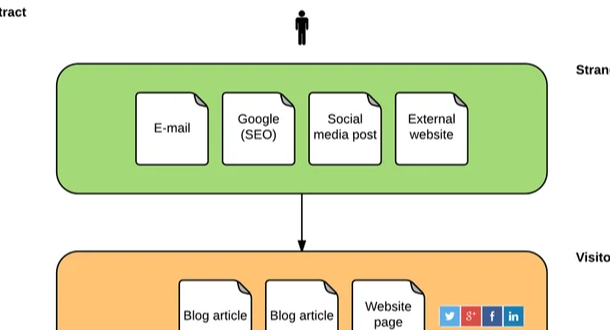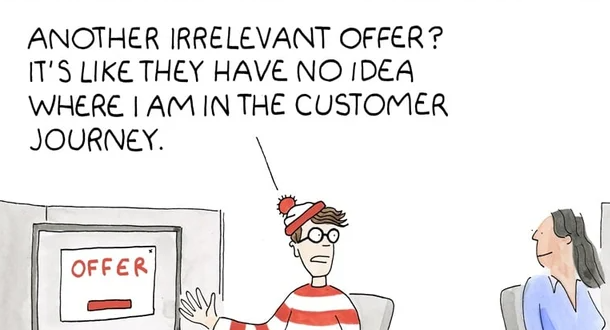Blogs, ebooks and white papers as conversion engines.
In an ideal world, your content is not only going to ensure that the reader becomes aware of a particular problem, but also that this potential customer is going to see your product or service as the solution to this problem, turn into a lead and eventually into a customer. Difficult? Yes. Impossible? Absolutely not.
Perhaps you've already started a blog article, or have already come up with the title of your first ebook (and are already proud of it). Many questions pass in review. What content do I offer and when? When is a blog article enough, and what content should I save for my ebook? What exactly is the difference between a white paper and an ebook?
Blog
Blogging cannot be left out of the online marketing starter kit. B2B companies that blog generate 67% more leads per month than those that do not(Source). Each new blog article is another indexed page and thus another opportunity to be found by your buyer persona in the search engines. And once you are found in the search engines with valuable content, this in turn opens many doors to creating more leads (and thus more customers).
Frequency and consistency
How often do you need to blog to achieve positive ROI? That simply depends on how often you want to be found. The less you blog, the fewer opportunities you have to attract leads. 82% of marketers who blog daily report receiving positive ROI for their efforts, 71% of marketers who blog 2-3 times a week and 67% of marketers who blog weekly. If you blog monthly, this percentage drops to 57%. Tip: blog frequently and consistently. If you start your blog with five articles per week, then you create expectations in the reader and it is annoying if that same reader suddenly has to make do with 1 article per week. But hey, it's up to you.
Write 1) for the reader and 2) for the search engine
First, a good blog includes a catchy title. Next, focus on one or more keywords you want to be found on and try to include them multiple times in both the title and the text. Choose keywords that increase your chances of ranking higher in the search engines (read: what is actually searched for by your buyer persona).
There is no golden rule for the number of words in a blog post. Take the space to convey your message well and clearly, keeping the focus on solving the visitor's problem. Finally, make sure your blog article has a catchy call to action in several places so the visitor can become a lead.
Ebook
As much as you might like it, a blog article cannot become dozens of pages long. Somewhere you're going to lose the reader's attention. Convert a visitor into a lead with an appropriate offer in the form of an ebook.
When is an ebook necessary?
What valuable information do you have in your hands that your potential customer absolutely doesn't want to miss, but needs to walk that proverbial "extra mile" for? That's when an ebook could be the right tool for you. The content in the ebook is more in-depth, has more weight than that of a blog. You get to dive deeper into the topic. The reader has identified their problem or need and is determined to solve it(consideration stage in the buyer journey). Your product or service might be the solution to the problem, and the key to that solution is in the ebook. In short, the ebook reinforces the trust relationship you've built with the blog.
How many pages should my ebook contain?
This depends on your goal and the time you want to spend on it. The purpose of your ebook also largely determines the number of pages you will devote to it. You're probably not going to give away a 150-page ebook for free! For a free ebook (which is the focus of this blog article), 10 to 20 pages is an acceptable length.
What an ebook shouldn't look like
The first mistake you can make when writing an ebook I'm going to tackle for you right now. Whatever you do, under no circumstances write an ebook that you think is what your reader needs. Need to be absolutely sure. Therefore, always start by establishing your buyer persona (and its pain points) and make sure you have insight into the buyer journey. Only then can you offer content that will actually provide solutions, insights and tools that are relevant to your reader/future lead/future customer.
The beginner/advanced guide
Make sure the offer fits the stage your reader is in. A blog article in the awareness stage is useless if it ends with a call to action inviting them to download the advanced manual. The reader will not feel addressed and will leave your blog (perhaps permanently). Make sure the offer matches the blog article (read: the stage in the buyer journey). The threshold for the reader to leave his data in exchange for your ebook is suddenly a lot lower.
Whitepaper
The definition of a whitepaper varies in different industries. We assume the following (free) translation: a whitepaper is an informative report on a specific topic, which presents a specific problem and its solution.
What is a white paper not?
The essence of a white paper is absolutely not product-centric. Once the reader finds out that - instead of the solution to his knowledge question - he or she has downloaded some kind of disguised version of your product brochure, chances are you have hooked a lead who will never turn into a customer. Make sure the white paper is informative in nature.
What is the difference between a white paper and an ebook?
Whitepapers are the academic papers of content marketing. More boring and serious, but no less important. Readers expect information based on a higher level of expertise, reinforced by well-founded facts and figures. In the B2B market, where decision-making processes are longer and more complex, white papers can be the ideal way to strengthen the relationship of trust. Writing a good white paper can take months, unlike a blog post or ebook that generally takes up several hours of your time.
A white paper is generally slightly more compact and shorter than an ebook, but is also heavier. So the difference is mainly in the density. An example: think of it as an open deciduous forest (the ebook) compared to a dense tropical jungle (the whitepaper). The whitepaper is harder to get through while you can mostly scan through an ebook. Also, one page in a whitepaper contains more facts and figures than one page in an ebook. You will probably not read the white paper all at once, but use it as a reference at different times.
Conclusion
We may conclude that a blog article is the first step in creating remarkable content. Ebooks and white papers can be appropriate offerings to turn a visitor into an engaged lead. An ebook is easily digestible, while a white paper is generally heavier and more serious in nature. The length and content of an ebook or white paper depend on your marketing and sales goals and, not unimportantly, the time you are willing to spend on it.
Such content creation is indicative of a company making strides in the digital landscape. Wondering how digitally mature your organization is? Do the Digital Maturity scan and find out for yourself:

Want to get the most out of HubSpot? Subscribe to our newsletter, follow us on LinkedIn, or attend our HubSpot User Days!
Explore HubSpot User DaysShare this
You May Also Like
These Related Stories

Business ebook writing: 20 tips for successful ebook

B2B marketing campaign example [Roadmap].


